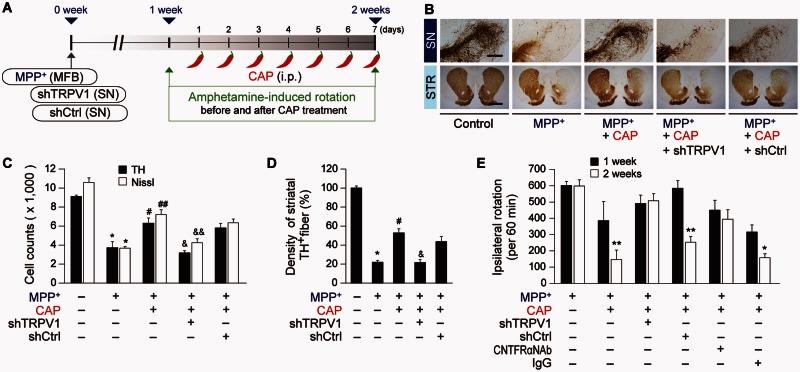Figure 1.
Capsaicin protects against degeneration of dopamine neurons from MPP+ neurotoxicity in vivo. (A) Diagram of the experimental design. Rats were given a unilateral medial forebrain bundle (MFB) injection of MPP+ followed by injection of shTRPV1 or shCtrl (control) into the substantia nigra (SN). All rats intraperitoneally (i.p.) received capsaicin (CAP; 1 mg/kg) or vehicle at 8 days post MPP+ and a continuous single injection per day for 7 days. Rats were transcardially perfused after the last rotation experiment. (B) Photomicrographs of TH+ cells in the SN and TH+ fibres in the striatum (STR). Scale bars: 400 µm (SN), 2 mm (STR). (C) Number of TH+ or Nissl+ cells in the SN pars compacta (SNpc). *P < 0.001, significantly different from control. #P < 0.01, ##P < 0.001, significantly different from MPP+. &P < 0.01, &&P < 0.001 significantly different from MPP+ + capsaicin. (D) Optical density of TH+ fibres in the striatum, *P < 0.001, significantly different from control. #P < 0.01, significantly from different from MPP+. &P < 0.01, significantly different from MPP+ + capsaicin. (E) Cumulative amphetamine-induced ipsilateral rotations, *P < 0.05, **P < 0.01, significantly different from 1 week in each group. shTRPV1 = TRPV1 shRNA lentivirus; shCtrl = scrambled shRNA lentivirus. Mean ± SEM; A, D, n = 5 to 13 in each group. E, n = 8 to 12 in each group. ANOVA and Student-Newman-Keuls analysis.

